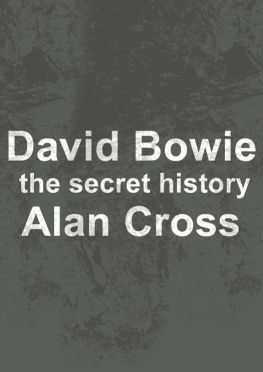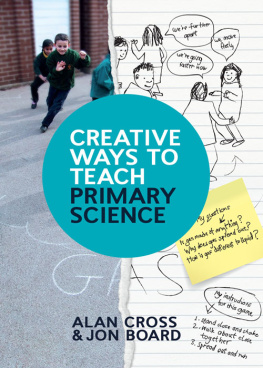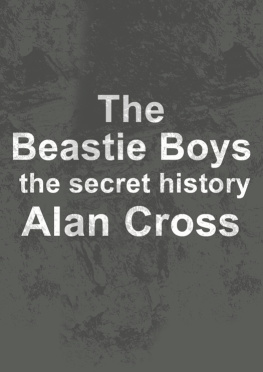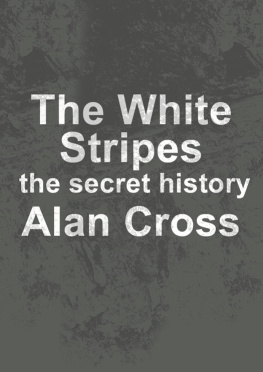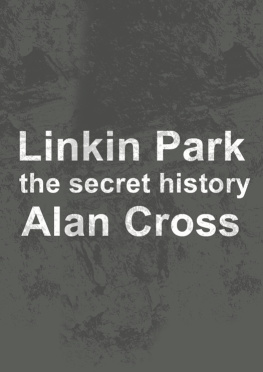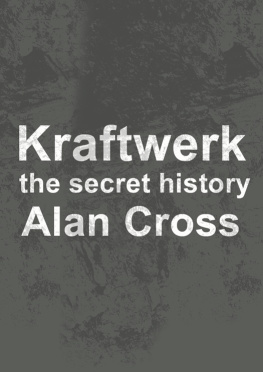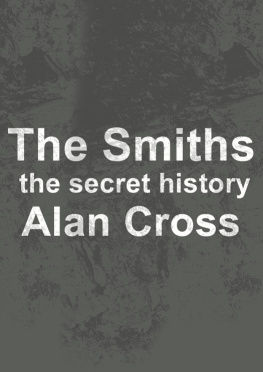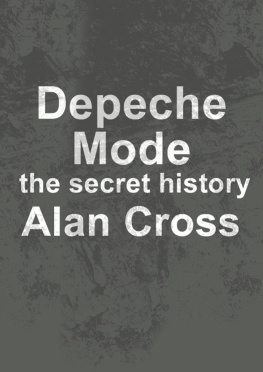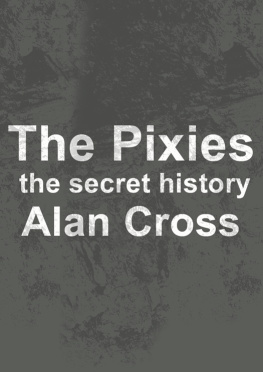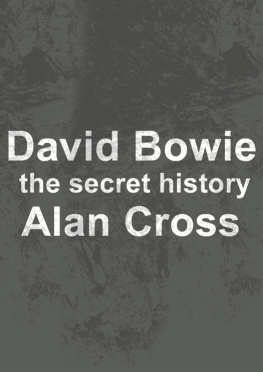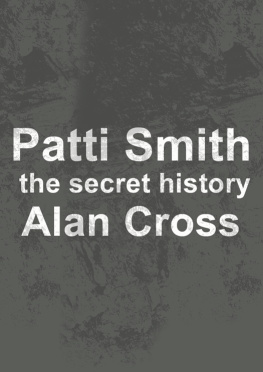Alan Cross - David Bowie: the secret history
Here you can read online Alan Cross - David Bowie: the secret history full text of the book (entire story) in english for free. Download pdf and epub, get meaning, cover and reviews about this ebook. year: 2011, publisher: HarperCollins Canada, genre: Non-fiction. Description of the work, (preface) as well as reviews are available. Best literature library LitArk.com created for fans of good reading and offers a wide selection of genres:
Romance novel
Science fiction
Adventure
Detective
Science
History
Home and family
Prose
Art
Politics
Computer
Non-fiction
Religion
Business
Children
Humor
Choose a favorite category and find really read worthwhile books. Enjoy immersion in the world of imagination, feel the emotions of the characters or learn something new for yourself, make an fascinating discovery.
- Book:David Bowie: the secret history
- Author:
- Publisher:HarperCollins Canada
- Genre:
- Year:2011
- Rating:4 / 5
- Favourites:Add to favourites
- Your mark:
- 80
- 1
- 2
- 3
- 4
- 5
David Bowie: the secret history: summary, description and annotation
We offer to read an annotation, description, summary or preface (depends on what the author of the book "David Bowie: the secret history" wrote himself). If you haven't found the necessary information about the book — write in the comments, we will try to find it.
David Bowie: the secret history — read online for free the complete book (whole text) full work
Below is the text of the book, divided by pages. System saving the place of the last page read, allows you to conveniently read the book "David Bowie: the secret history" online for free, without having to search again every time where you left off. Put a bookmark, and you can go to the page where you finished reading at any time.
Font size:
Interval:
Bookmark:
Hes been known by many names over the years: Ziggy Stardust, Aladdin Sane, Halloween Jack, Plastic Soul Man, the Thin White Duke. In any other line of work, he might have been written off as a terminal case of attention deficit disorder. But because this is the music business, David Bowies carefully calculated makeovers became not only highly admired but widely copied. His ever-changing methods of presentation added a new and sophisticated element of make-believe to the world of rock and roll. Under his various guises, Bowie experimented with composition, image and theater. In the process, he left an indelible mark on virtually the entire spectrum of what would eventually be called alternative music. Few (if any) artists have demonstrated such deftness and dexterity, and fewer still can boast of influencing everyone from the early punks to the electronic and industrial acts at centurys end.
Two other children completed this hodgepodge family: an adopted daughter named Myra Ann, and Annette, Johns daughter by a previous marriage. Home was an unremarkable red-brick Victorian row house at 40 Stansfield Road in Brixton, an area populated mostly by Jamaican immigrants and a few Irish. In 1955, the family moved to Bromley, settling into another quite ordinary house at 4 Plaistow Grove.
As owner of a nearby club for wrestlers, John Jones had access to the hundreds of records destined for the clubs jukebox. When he heard some Little Richard singles in 1956, eight-year-old David became hooked and soon declared that one day, he would be the greatest star in England. This infatuation with rock and roll was encouraged by Terry, who was already into Bill Haley and Elvis Presley.
David found his first real musical instrument under the Christmas tree in 1959. It was a Selmer saxophone, the same kind heard on some of those Little Richard records. A few weeks later, Terry arranged for David to take formal lessons from a man named Ronnie Ross for 2 a session. This led to experiments on the family piano and eventually a skiffle group with George Underwood, a classmate at Bromley Technical High School. For the record, Davids first public musical performance seems have been at a gathering of Cub Scouts on the Isle of Wight in 1959, where he and George entertained the troop with a couple of Lonnie Donegan songs.
Back at school, David formed his first group. With their matching suits, white shirts and striped ties, the Kon-Rads featured David on sax and vocals as they covered the popular tunes of the day. The only thing that really distinguished them from the other bands at school was Davids hair; he was always changing styles and colors, even to the extent of using a few streaks of orange.
When he was 14, David and George got into a scrap over a girlfriend, and David took several solid punches to the face. Both eyes were damaged, although the left one took the brunt of the punishment and began bleeding profusely. David ended up in hospital, and doctors worked for months to save his sight. An operation saved the right eye, but the left pupil remained paralyzed, a condition called traumatic mydriasis. Strangely, as his eyes healed, they became different colors; to this day his right eye remains blue while the left is a shade of brown.
In July 1963, David dropped out of school to take a job with J. Walter Thompson, an American advertising agency. Nights were spent prowling the jazz and R&B clubs in Soho with George. Late that year, they took the plunge, forming a band called the Hookers, who, by early 1964, had evolved into the King Bees. John Jones was so impressed by his sons attempts at a career in music that he secured a sponsor for the King Bees (a washing machine company) that led to a recording session with Vocaliton, a subsidiary of Decca Records.
Since no one in the group demonstrated any songwriting potential, they recorded two covers, picking up on the quasi-mod sound of the day. The A-side, Liza Jane, was an old African American spiritual picked out by Leslie Conn, a music publisher who was a friend of the washing machine tycoon. Side B was the King Bees choice: a cover of Paul Revere and the Raiders minor hit Louie Louie Go Home. The King Bees released their one and only single on June 5, 1964, under the name Davie Jones with the King Bees. Any illusions the group might have had of becoming as big as the Beatles were wiped out the following day when a BBC-TV program called Juke Box Jury declared that both sides of the record were completely devoid of any commercial potential. Interestingly enough, anyone fortunate enough to own an original copy has something worth in the neighborhood of $500 today.
Having accepted defeat, David turned to the musicians wanted section of Melody Maker and arranged a meeting with a group from Maidstone called Band Seven. Renaming themselves the Manish Boys, they issued a single on Parlophone. Released on March 5, 1965, it featured a cover of a 1961 hit by Bobby Bland called I Pity the Fool on side one (the recording features a few choice guitar licks from a young session musician named Jimmy Page); side two was Take My Tip, the first-ever recording of a David Jones composition. Although the Manish Boys showed potential and had a flair for publicity (their gimmick was long hair; see the League for the Preservation of Animal Filament in ), they were unable to find any chart success, though they toured briefly with Gerry and the Pacemakers in November 1965.
Davids third stab at recording came after a merger with a group called the Lower Third (he passed the audition by ripping through the sax parts of a Little Richard song he had learned as a boy). Raising money by writing a couple of radio commercials for an American clothing company called Youthquake, Davy Jones and the Lower Third released a single entitled Youve Got a Habit of Leaving on August 20, 1965. Once again, the record-buying public wasnt interested.
Whatever the case, the first single to feature the name David Bowie on the label was released in January 1966 on Pye. Cant Help Thinking about Me backed with And I Say to Myself was credited to David Bowie and the Lower Third, even though all his live performances at the time involved a band called the Buzz. For the first time, Bowie saw a little chart success as Cant eventually climbed to number 34 on Melody Makers singles chart. It was also the Lower Thirds firstand lastAmerican release.
Less than a month after Cant was released, the Lower Third split up, leaving Bowie a solo performer for the first time in his life. Using the members of the Buzz (who were paid 9) he quickly recorded a single entitled Do Anything You Say that was issued on Pye on April 1, 1966. Following a six-week engagement at Londons famed Marquee Club (a mod-ish presentation entitled The Bowie Showboat), his final Pye single, I Dig Everything, was released on July 5. Switching to Deram Records, Bowie dashed off a couple of songs during a one-day recording session on October 18 and issued Rubber Band in December 1966.
Between 1967 and 1969, Bowie embarked on a number of creative experiments, initially to the detriment of his career. One of the first was a novelty single entitled The Laughing Gnome (released on April 14, 1967, through Deram) which was dismissed as an attempt to ape Anthony Newley, a famous song-and-dance man of the time. A July follow-up, Love You Til Tuesday, was another failure. His debut album (David Bowie, June 1967) was totally ignored. A fed-up Deram gave Bowie the boot.
With no remaining alternatives as a recording artist, Bowie was forced to face the fact that he might not have a career in music. It took a stint in a Buddhist monastery in Scotland to give him the strength to continue. Back in London, he began taking mime and dance lessons from Lindsay Kemp, a former student of Marcel Marceau. Although Bowie didnt consider mime to be his lifes calling, these workshops did give him a new appreciation of theater and some new ideas about a cabaret/coffeehouse act. The work with Kemp also led to an opportunity to write some music for BBC-TV in December 1967 with staff producer Tony Visconti. Over the next few months, Bowie puttered at a series of odd jobs. In addition to the BBC work, he was cast in a TV commercial for LUV ice cream and took a job at Legastat Document Copiers. Then came Feathers, a short-lived acoustic trio featuring Hermione Farthingale (Bowies girlfriend) and bassist John Hutchison.
Font size:
Interval:
Bookmark:
Similar books «David Bowie: the secret history»
Look at similar books to David Bowie: the secret history. We have selected literature similar in name and meaning in the hope of providing readers with more options to find new, interesting, not yet read works.
Discussion, reviews of the book David Bowie: the secret history and just readers' own opinions. Leave your comments, write what you think about the work, its meaning or the main characters. Specify what exactly you liked and what you didn't like, and why you think so.

